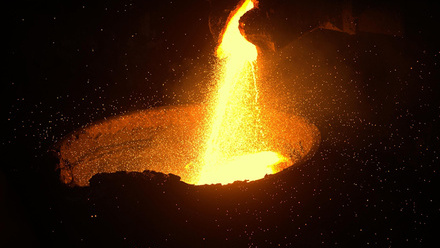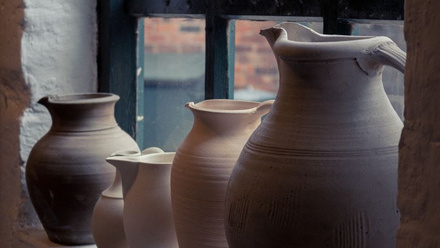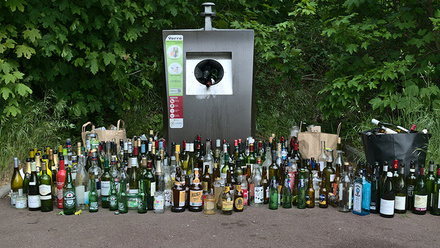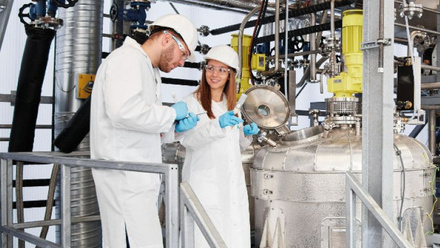Material Marvels: The Vespa
Piaggio’s most iconic product was revealed in the Rome Golf Club in 1946 – a scooter named Vespa. We discover the history behind the creation, its evolution and the materials used.
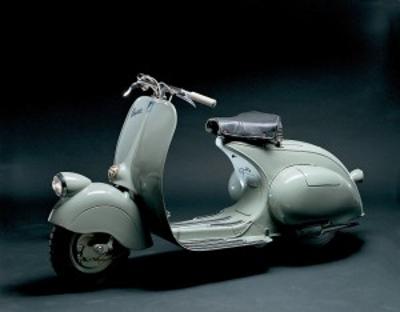
The Vespa 98
© PIAGGIO.Vespa is manufactured by Italian company Piaggio & Co and was born out of the company’s headquarters in Pontedera in Tuscany, Italy. It is known for its simple, elegant design that resembles a woman's step-through bicycle with the slanted bar and open body. Over the years, the design has hardly changed.
‘The Vespa underwent no ageing process in either looks or function because, from the very first model in 1946, its shape was so new and different that it had very little in common with the style of two-wheeled or four-wheeled vehicles at the time. This uniqueness prevented it from looking dated like the motorcycles of those years, or the Fiat 500 or the Mini Minor,’ Late Florence University Industrial Design Professor, Roberto Segoni, wrote in the book Vespa: Italian style for the world.
With more than 18 million scooters sold since its launch, its appearance in movies such as in La Dolce Vita and Roman Holiday, inclusion in several museums and being favoured among celebrities such as Jude Law, Diane Kruger, Tom Hanks, Brad Pitt and Gwyneth Paltrow, the wasp-shaped scooter earned its label as young, fashionable and accessible.
Motoring and WWII
Scooters were by no means Piaggio’s first endeavour – before the two-wheeler, the company had over 60 years’ experience in other types of manufacutring including producing fitting for ships, railcar construction and airplane engines. In 1887, Rinaldo Piaggio transformed Società Rinaldo Piaggio into Piaggio & Co, where he functioned as Director and Managing Partner of the then carpentry business. ‘The Piaggio carpenters produced the fittings for the finest Italian and foreign ships built at the end of the century. The company then expanded into railcar construction, at the time a more innovative sector with important growth prospects. Subsequently, with the opening up of the new frontier of aeronautics, Piaggio workers began building aircraft wings and fuselage from 1917. Looking for a new site, Rinaldo took over a Pisa-based company and set down Piaggio’s first roots in Tuscany,’ the Piaggio group magazine, Wide, read.
It was not until after Rinaldo died, and his two sons, Enrico and Armando, took over the company while it still was producing aircraft engines, lorries and buses, that the move to making the Vespa began.
After WWII, the Pontedera factory, which was under the management of Enrico Piaggio, was severely damaged. Therefore, Enrico was on the lookout for a new opportunity. ‘His ambition was to help Italy overcome its post-war transport difficulties. He ventured into the complexities of Italian reconstruction with a specific idea – to build a simple, low-cost means of transport that would consume very little and could be ridden by men and women alike,’ Wide magazine read.
The idea of the Vespa was born when Enrico visited the re-located Pontedera factory and saw the small Paperino scooter. He liked the idea of the vehicle, but not its design. He then assigned the task of creating a new design, inspired by the vehicle, to engineer, Corradino D’Ascanio.
The prototype is born
After a couple of weeks, D’Ascanio created a prototype often referred to as MP6. When Enrico first saw the vehicle, he said ‘Sembra una vespa’ – it looks like a wasp. ‘The most significant characteristic of the MP6 was the use of a pressed steel monocoque body with a protective leg shield covering the single tube support of the offset front wheel,’ Florence University former Industrial Design Professor, Ornella Sessa, wrote in the book.
She added that the steel panels were assembled and electrically spot welded, which made it stronger and resulted in the classic style.
The scooter’s design was influenced by several criteria – it needed to be easily accessible, hence the open leg space, and for the engine to be at the rear of the vehicle. Allowing the driver to place their feet on the ground easily when stopping added to the safety of the bike over traditional motorcycles. Another manoeuvrability decision was to mount all of the controls on the handlebars, a decision which was later patented in 1946 when the first model was released.
‘As for the engine, it had to be covered and isolated from the rest of the vehicle, located far from the rider but at the same time easily accessible for maintenance. They therefore decided to put the engine at the rear, making it a single unit with the rear wheel. The need to cover the engine was resolved by using a wing-shaped cowling,’ Sessa explained. ‘The upper edge of this slotted into a rubber-sealed groove on the main body of the vehicle and it was secured in place by two studs. The chainless transmission, with the gearbox in line with the engine and included in the wheel-engine unit, was a result of these choices.’
Vespa 98
On 23 April 1946, a patent was filed in Florence, Italy, and accepted on 9 November 1946.
Both international and Italian press was attending the event in Rome where the MP6 prototype-turned-Vespa 98 was launched.
Sales, however, were slower than anticipated. At this point, Piaggio had manufactured approximately 50 Vespas – the first 48 were sold but selling the last two scooters was a struggle, ‘but then day after day things picked up until it seemed they would never stop,’ the book stated.
The first model was produced throughout 1947, and four versions were released in this time period, with changes to the bodywork and mechanical details. One of these was ensuring that the kick-start pedal was more accessible and easier to use. This was done by making it slightly curved and longer.
‘In production terms, the whole constructional concept brilliantly solved a number of problems which still today are encountered in the construction of modern motorcycles – an excessive number of components making up the whole, inadequately rationalised methods to connect different components together, and materials usage, which had to be optimised to save weight and, as a result, to improve power/weight ratio,’ according to Sessa.
‘The monocoque chassis, made by spot welding a small number of pressed steel elements, offers great rigidity, as well as being less expensive and simpler to manufacture, both in terms of ease of assembly and painting, the latter is reduced to a single-step process.’
Speeding ahead
Production of the Vespa escalated rapidly. Only a year after the launch, the company was producing more than 500 scooters per month despite the lack of a proper factory, and it was common for workers to encounter blackouts.
Following that, Piaggio produced another 33 Vespa scooter models with several versions of the models, and in 1988, the company sold its 10 millionth Vespa.
Piaggio now holds brands Piaggio, Vespa, Aprilia, Moto Guzzi, Gilera, Derbi and Scarabeo and produce two-wheeled vehicles including motorcycles, scooters and mopeds.
Today, the modern Vespa is also made entirely from steel and is still made at the Pontedera headquarters. The manufacturing process has become automated and mounting of the steel is conducted using a spot and arc welding process, which is now executed by a machine, instead of manually.
The steel body is then transferred to an expert operator to check for defects in the steel and subsequently fix them manually, before the body is covered in a black cataphoresis primer. Then, the joining between the left and right part of the body, the front shield and the footwork is sealed by operators.
Another layer of primer is added to strengthen adhesion between the cataphoresis and the base coat. A black or grey primer will be added for darker coloured vehicles, while a white primer is for brighter coloured vehicles. Machines paint the component before it is cured at 85°C for 40 minutes and sent to polish.
It then gets moved by conveyor belts to the final assembly line. The Pontedera factory has six assembly lines - three that work on other Piaggio brands, Liberty, NRG, MP3 and Beverly, and three that assemble Vespa GTS, Vespa Primavera, Vespa Sprint, Vespa 946 and Vespa Elettrica.
Every three minutes, there is a new Vespa fully assembled at the factory. The final construction process is completed by hand using electric screwdrivers.
Going electric
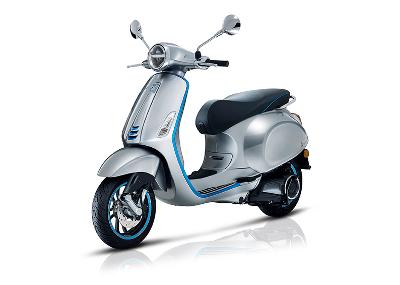
In Genoa, Italy, there has been an ongoing battle between Vespa-lovers and local authorities since 2016, when the council first tried to introduce the anti-Vespa law, according to The Local Italy.
The law was to ban the use of older models produced before 1999 which run on two-stroke engines. This change could limit pollution and make the city cleaner.
According to The Local Italy, Genoa Mayor Marco Bucci, said a transition to electric vehicles would be prioritised, pledging that subsidies and funding would be accessible for replacement vehicles.
In response to pressure from environmental enthusiasts, on 8 October 2018, Piaggio announced the launch of an electric version, Vespa Elettrica.
While the new scooter is electric, the design resembles the old classics, such as Vespa 98 and other early models. The scooter is powered by a battery and has a 100km range in one charge, engine power of 4kW and zero carbon dioxide emissions.
‘The Vespa Elettrica has a maximum range of 100km, a value that changes little between urban and extra-urban environments thanks to the scooter’s modern lithium-ion battery and efficient kinetic energy recovery system, which recharges the battery during deceleration. To recharge the battery, the rider simply plugs the cable located in the compartment below the saddle into a normal electric wall socket, or into one of the recharging points that are becoming a common sight in today's cities. A complete recharge normally takes four hours,’ a company release read.
On 4 September 2019, Bucci announced that the law was awaiting approval from the council.
While the recognisable sound and smell of the early models may be a feature of the past, the character of the wasp remains a common thread.




